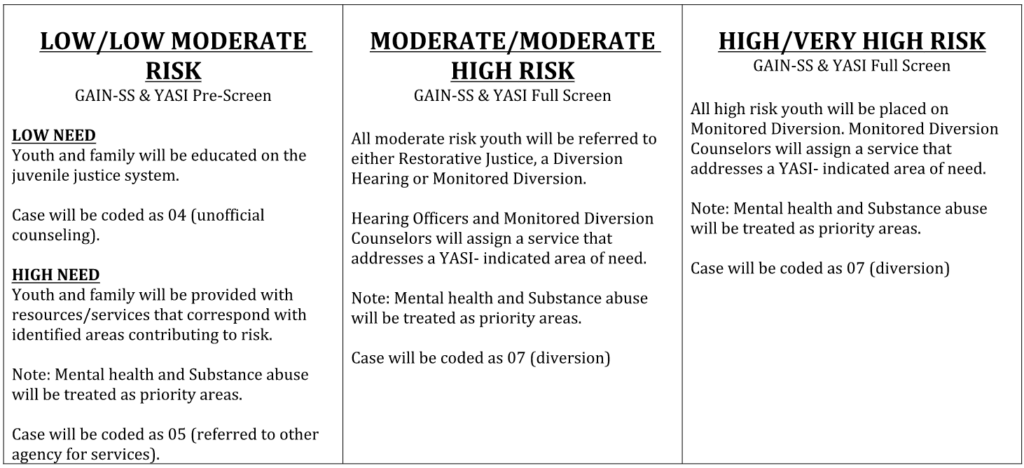2016 Capstone of the Year
Fairfax County, VA Team

Pictured left to right front row: Erin Schaible (FCPD); Tracey Chiles (JDRDC); Lori Winter (JDRDC); Matt Thompson (JDRDC); Courtney Porter (JDRDC); Katrina Smith (JDRDC).
Not Pictured: Bill Fulton (FCPD); Andy Wehrlen (FCPD); Ailsa Burnett (JDRDC); MaryAnn Panarelli (FCPS).
The Center for Juvenile Justice Reform (CJJR) at the Georgetown University McCourt School of Public Policy is proud to announce the Fairfax County, Virginia team as the winner of the 2016 Capstone of the Year Award. After attending CJJR’s October 2014 Juvenile Diversion Certificate Program, the team developed and implemented a Capstone Project aimed at improving outcomes for youth participating in diversion and restorative justice programs in Fairfax County. In addition to demonstrating strong, multi-system collaboration designed to increase successful program completion and decrease recidivism, the team is using a data-driven approach to reduce racial and ethnic disparities at the point of system referral.
The original Fairfax County Certificate Program team members who attended the Juvenile Diversion Certificate Program at Georgetown University included Elizabeth Jones, Erin Schaible, Jamie McCarron, Katrina Smith, Lori Winter, Tracey Chiles, Tracey Jenkins, Vickie Shoap, and William Fulton. The team later added new members, Ailsa Burnett, Shawn Martin, MaryAnn Panarelli, Courtney Porter, Matt Thompson, and Andrew Wehrlen to help support the implementation of the Capstone Project. Collectively, these individuals represent the following organizations: Fairfax County Juvenile and Domestic Relations District Court, Fairfax County Police Department, Fairfax County Government, Fairfax County Public Schools, and the Virginia Department of Criminal Justice.
Through their Capstone Project, the Fairfax County team expanded the Alternative Accountability Program (AAP), a community restorative justice program that serves as an early diversion option for youth involved in the juvenile justice system. The program uses a victim-centered response to juvenile offenses and provides eligible youth an opportunity to acknowledge their involvement in incidents and explore ways to repair the harm in terms that meet victims’ needs. The development of AAP is a direct result of collaboration between Certificate Program team members, their respective agencies, and community partners, including the Court Services Unit (CSU), the Fairfax County Police Department, the Fairfax County Public Schools, and Northern Virginia Mediation Services. Representatives from these agencies formed the Community Restorative Justice Work Group and signed an MOU to support the implementation of the AAP.
To complement their diversion efforts, the Fairfax County team also redesigned the juvenile intake process to better incorporate evidence-based assessments. The team put together an Intake Assessment Work Group to review and improve the existing intake process for diversion, revise the use of screening and assessment tools, and create a diversion dispositional matrix that incorporates youth’s risk and needs based on their screening and assessment results. The Youth Assessment and Screening Instrument (YASI) and the Global Appraisal of Individual Needs – Short Screen (GAIN-SS) were selected as the screening and assessment instruments, and all juvenile intake officers were trained to use both tools. These changes enabled CSU staff to use empirical tools to determine the most appropriate levels of supervision and services for youth.

Fairfax County’s Juvenile Intake Dispositional Matrix
Preliminary data indicates that the impact of the Capstone Project on youth outcomes is extremely promising. Since the inception of the Capstone Project, there have been a total of 449 youth participants in the diversion process overall. Whereas only 79 percent of youth successfully completed diversion in 2012, in 2016 this number rose to 95 percent. Of the youth referred to a diversion program based on the newly developed assessment process (i.e., informed by the YASI, GAIN-SS, and diversion disposition matrix), 83% did not recidivate within six months. While AAP participants are not captured in this recidivism data (due to the program’s infancy), initial indicators also suggest success. Within the first six months of implementation, 99% of youth are compliant with agreed upon program conditions. The team expects to produce recidivism data on the AAP later this year.
The team is also intentionally gathering and analyzing data on racial and ethnic disparities, an effort led by CSU’s Research and Development Unit and a Data Work Group specifically tasked with data collection. Initial data showed that despite the team’s efforts to enhance the intake process, the diversion eligibility rates differed starkly for African-American youth (34%) compared to their white counterparts (50%). A more in-depth analysis revealed that a large number of youth of color were ineligible for diversion due to some form of prior or current court involvement and/or excessive restitution. To address this issue, the Fairfax County team worked to change the diversion eligibility criteria offered by the CSU. More specifically, without changing the relative weight of the youth’s risk of recidivism, the team increased the maximum number of charges allowed for diversion from three to five, and removed restitution as a factor for diversion eligibility.
Team members are continuing their efforts to decrease racial and ethnic disproportionality and expand diversion options for youth in Fairfax County and nearby jurisdictions by encouraging all police stations to refer youth to the AAP, developing new diversion programs for youth, and reviewing policies and practices around diversion eligibility. The team has also been working diligently to promote changes in state and county law in order to improve interagency collaboration and data-sharing ability. For example, the team supported HB 541, a bill passed by the Virginia legislature that allows police records to be shared for the purpose of juvenile diversion. Before HB 541 took effect on July 1, 2016, the Fairfax County Police Department could not share youth’s arrest records with AAP staff.
We congratulate the Fairfax County team on their selection as the 2016 Capstone of the Year Award winner and look forward to their ongoing efforts to improve outcomes for youth and communities in Northern Virginia.
About the Capstone of the Year Award
The Capstone of the Year Award recognizes the Certificate Program participant or team, who, through their Capstone Project, has made the most significant progress promoting the well-being of youth through multi-system approaches in their community. All CJJR Fellows are eligible to receive the award, regardless of the year of their participation in a Certificate Program.
The winner of the award receives national recognition for their accomplishment through a release of a Georgetown University publication highlighting their work and is awarded free tuition and travel for one person to attend a future CJJR Certificate Program of their choosing. First awarded in March 2012, this award serves to honor and recognize the success, innovation, and tremendous work of CJJR Fellows through their Capstone Projects.
The Fairfax County, Virginia team participated in the 2014 Juvenile Diversion Certificate Program – an intensive training designed to bring together individuals and teams of law enforcement officers, probation staff, prosecutors, school officials, judges, policymakers, and other local child-serving leaders to strengthen their diversion efforts. The purpose of the program is to provide participants with the knowledge and tools needed to implement or improve juvenile diversion programming in their jurisdiction, thereby reducing the use of formal processing and incarceration, improving public safety, avoiding wasteful spending, and limiting the collateral consequences youth encounter from exposure to the juvenile justice system. Upon completion of the Certificate Program, participants become CJJR Fellows by designing and implementing a Capstone Project focused on diversion reform in their jurisdiction. CJJR currently has over 800 Fellows who receive ongoing support for their work and benefit from being part of a growing network of mutually supportive leaders.
